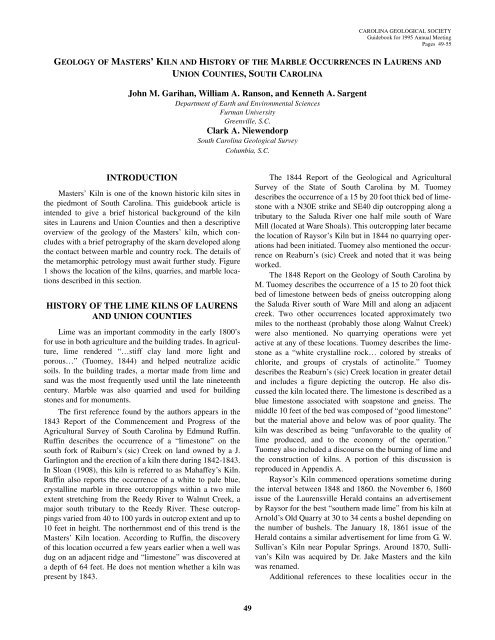Download Guidebook as .pdf (29.1 Mb) - Carolina Geological Society
Download Guidebook as .pdf (29.1 Mb) - Carolina Geological Society
Download Guidebook as .pdf (29.1 Mb) - Carolina Geological Society
Create successful ePaper yourself
Turn your PDF publications into a flip-book with our unique Google optimized e-Paper software.
CAROLINA GEOLOGICAL SOCIETY<br />
<strong>Guidebook</strong> for 1995 Annual Meeting<br />
Pages 49-55<br />
GEOLOGY OF MASTERS’ KILN AND HISTORY OF THE MARBLE OCCURRENCES IN LAURENS AND<br />
UNION COUNTIES, SOUTH CAROLINA<br />
John M. Garihan, William A. Ranson, and Kenneth A. Sargent<br />
Department of Earth and Environmental Sciences<br />
Furman University<br />
Greenville, S.C.<br />
Clark A. Niewendorp<br />
South <strong>Carolina</strong> <strong>Geological</strong> Survey<br />
Columbia, S.C.<br />
INTRODUCTION<br />
M<strong>as</strong>ters’ Kiln is one of the known historic kiln sites in<br />
the piedmont of South <strong>Carolina</strong>. This guidebook article is<br />
intended to give a brief historical background of the kiln<br />
sites in Laurens and Union Counties and then a descriptive<br />
overview of the geology of the M<strong>as</strong>ters’ kiln, which concludes<br />
with a brief petrography of the skarn developed along<br />
the contact between marble and country rock. The details of<br />
the metamorphic petrology must await further study. Figure<br />
1 shows the location of the kilns, quarries, and marble locations<br />
described in this section.<br />
HISTORY OF THE LIME KILNS OF LAURENS<br />
AND UNION COUNTIES<br />
Lime w<strong>as</strong> an important commodity in the early 1800’s<br />
for use in both agriculture and the building trades. In agriculture,<br />
lime rendered “…stiff clay land more light and<br />
porous…” (Tuomey, 1844) and helped neutralize acidic<br />
soils. In the building trades, a mortar made from lime and<br />
sand w<strong>as</strong> the most frequently used until the late nineteenth<br />
century. Marble w<strong>as</strong> also quarried and used for building<br />
stones and for monuments.<br />
The first reference found by the authors appears in the<br />
1843 Report of the Commencement and Progress of the<br />
Agricultural Survey of South <strong>Carolina</strong> by Edmund Ruffin.<br />
Ruffin describes the occurrence of a “limestone” on the<br />
south fork of Raiburn’s (sic) Creek on land owned by a J.<br />
Garlington and the erection of a kiln there during 1842-1843.<br />
In Sloan (1908), this kiln is referred to <strong>as</strong> Mahaffey’s Kiln.<br />
Ruffin also reports the occurrence of a white to pale blue,<br />
crystalline marble in three outcroppings within a two mile<br />
extent stretching from the Reedy River to Walnut Creek, a<br />
major south tributary to the Reedy River. These outcroppings<br />
varied from 40 to 100 yards in outcrop extent and up to<br />
10 feet in height. The northernmost end of this trend is the<br />
M<strong>as</strong>ters’ Kiln location. According to Ruffin, the discovery<br />
of this location occurred a few years earlier when a well w<strong>as</strong><br />
dug on an adjacent ridge and “limestone” w<strong>as</strong> discovered at<br />
a depth of 64 feet. He does not mention whether a kiln w<strong>as</strong><br />
present by 1843.<br />
The 1844 Report of the <strong>Geological</strong> and Agricultural<br />
Survey of the State of South <strong>Carolina</strong> by M. Tuomey<br />
describes the occurrence of a 15 by 20 foot thick bed of limestone<br />
with a N30E strike and SE40 dip outcropping along a<br />
tributary to the Saluda River one half mile south of Ware<br />
Mill (located at Ware Shoals). This outcropping later became<br />
the location of Raysor’s Kiln but in 1844 no quarrying operations<br />
had been initiated. Tuomey also mentioned the occurrence<br />
on Reaburn’s (sic) Creek and noted that it w<strong>as</strong> being<br />
worked.<br />
The 1848 Report on the Geology of South <strong>Carolina</strong> by<br />
M. Tuomey describes the occurrence of a 15 to 20 foot thick<br />
bed of limestone between beds of gneiss outcropping along<br />
the Saluda River south of Ware Mill and along an adjacent<br />
creek. Two other occurrences located approximately two<br />
miles to the northe<strong>as</strong>t (probably those along Walnut Creek)<br />
were also mentioned. No quarrying operations were yet<br />
active at any of these locations. Tuomey describes the limestone<br />
<strong>as</strong> a “white crystalline rock… colored by streaks of<br />
chlorite, and groups of crystals of actinolite.” Tuomey<br />
describes the Reaburn’s (sic) Creek location in greater detail<br />
and includes a figure depicting the outcrop. He also discussed<br />
the kiln located there. The limestone is described <strong>as</strong> a<br />
blue limestone <strong>as</strong>sociated with soapstone and gneiss. The<br />
middle 10 feet of the bed w<strong>as</strong> composed of “good limestone”<br />
but the material above and below w<strong>as</strong> of poor quality. The<br />
kiln w<strong>as</strong> described <strong>as</strong> being “unfavorable to the quality of<br />
lime produced, and to the economy of the operation.”<br />
Tuomey also included a discourse on the burning of lime and<br />
the construction of kilns. A portion of this discussion is<br />
reproduced in Appendix A.<br />
Raysor’s Kiln commenced operations sometime during<br />
the interval between 1848 and 1860. the November 6, 1860<br />
issue of the Laurensville Herald contains an advertisement<br />
by Raysor for the best “southern made lime” from his kiln at<br />
Arnold’s Old Quarry at 30 to 34 cents a bushel depending on<br />
the number of bushels. The January 18, 1861 issue of the<br />
Herald contains a similar advertisement for lime from G. W.<br />
Sullivan’s Kiln near Popular Springs. Around 1870, Sullivan’s<br />
Kiln w<strong>as</strong> acquired by Dr. Jake M<strong>as</strong>ters and the kiln<br />
w<strong>as</strong> renamed.<br />
Additional references to these localities occur in the<br />
49













